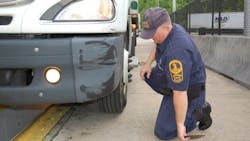Here's how to make Roadcheck 2018 work for you
LOUISVILLE. Truckers with high Inspection Selection System (ISS) scores may be dreading the upcoming Commercial Vehicle Safety Alliance’s (CVSA) International Roadcheck. But they shouldn’t. In fact, it might be in their best interest to embrace the annual inspection blitz.
During this year’s Mid-America Trucking Show (MATS), industry veteran and CDL-holder Robert Petrancosta, vice president of fleet safety at SMS360, explained to truckers that the only way to lower their score is to endure – and pass – more inspections.
“Eventually you will wipe that slate clean,” Petrancosta explained during a Beyond CSA (Compliance, Safety, Accountability): Getting back to BASICS seminar at MATS. “You want to welcome those inspections. I know of drivers that take off during that Roadside Inspection week. If I’m a driver, I want to be inspected during that time because I know ahead of time what they’re looking for.”
Earlier this week, CVSA set its annual International Roadcheck dates for June 5-7. This year’s 72-hour inspection blitz targets hours of service (HOS) compliance due to the recent implementation of the electronic logging device mandate.
There are eight levels of inspections ranging from the Level I Inspection, which evaluates both the driver and vehicle, to inspection levels with a more specific area of focus, such as Level VI for radioactive materials and Level VIII for electronic inspections.
Petrancosta pointed out that drivers should always be aware of what kind of inspection enforcement officers will conduct when they are pulled over or stopped at a weigh station. For instance, the only relevant violations, citations or warnings for a Level III inspection, which is a driver-only inspection, are driver related.
So what happens if during a Level III inspection, inspectors find vehicle violations? Can those ultimately be reported in the roadside inspection?
“Sure they can,” Petrancosta said. “But they should not be counted against you in that BASIC (Behavior Analysis and Safety Improvement Categories) because it’s not a relevant inspection. It’s a key thing to know because I guarantee you that gets glossed over quite a bit.”
When looking at a carrier’s ISS scores, enforcement officers will typically follow the following criteria: a score ranging from 0-49 means there’s a 2% chance the driver will be pulled over for an inspection; scores ranging from 50-74 could mean an optional inspection; and scores that are in the 75-100 range will result in an automatic inspection.
Petrancosta provided the following criteria that truckers should look out for to prevent those scores from rising:
Observable defects such as a broken or cracked windshield. Or if inspectors see that drivers aren’t wearing their seatbelts, or spot a leaking wheel hub.
“I am a driver and I was a driver, and those are the things that I made sure were absolutely inspected before my destination,” Petrancosta explained.
Moving violations such as speeding, running a stop sign, weaving, tailgating or any other reckless driving behaviors.
“They already know something about you at that point,” Petrancosta noted. “They know that you exhibited unsafe behavior, and we know from studies that unsafe behavior leads to more unsafe behavior.”
About 25% of roadside inspections are triggered by a suspected moving violation.
Keep an eye on equipment. Petrancosta pointed out that 30% of all roadside violations deal with lights. Six points can be added to a carrier’s score for a broken light, and in some cases, can result in an out-of-service violation.
Overall, more than 11% of vehicle violations are for tires (half of those are for tread depth). Brakes should also be inspected during every pre-trip, he added.
Medical cards. Failure to have a valid medical certificate is one of the top driver violations every year. Though it’s only a one-point violation, it’s easy to avoid, Petrancosta said.
And at all costs, avoid red flag violations. Red flag violations, such as operating without a valid CDL or under the influence of drugs or alcohol, are considered by the FMCSA as the worst violations a single driver could incur during an inspection. There are 12 violations that are considered red flags.
About the Author

Cristina Commendatore
Cristina Commendatore is a past FleetOwner editor-in-chief. She wrote for the publication from 2015 to 2023.
